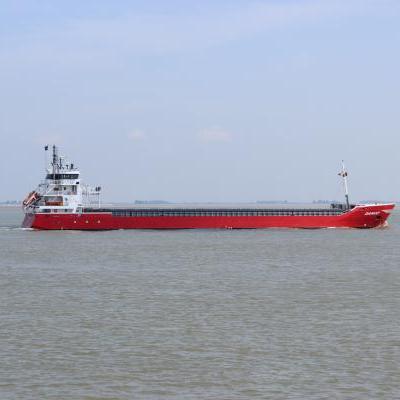Captain (Kapitein)
Information on this skill...
A captain is the supervisor on board a ship. As a captain you are ultimately responsible on board a ship and, depending on the type of ship, you usually manage various other maritime employees. If a captain does not work as a captain himself, for example because he or she is resting, the helmsman takes over the work. A helmsman is deputy captain if the captain himself is not present. The helmsman is under the supervision of the captain and will consult the captain in difficult decisions. The profession of captain belongs to seafaring. When we talk about inland shipping, the name skipper is more appropriate. This does not alter the fact that an inland skipper may also be called a captain. The maritime personnel working directly under the captain report to the captain on a daily basis. It is the captain who maintains contact with the various authorities with which the ship has to deal during the voyage. The profession of captain is a profession with many responsibilities, because a captain must always put safety first. Another name for captain can also be maritime officer. The profession of captain has a great appeal to many people, because the profession of captain can be regarded as a special profession. The profession of captain should be seen as quite common as a captain can work in a variety of ways. Working as a captain on an inland vessel cannot simply be compared with the work of a sea captain. As a captain, there is therefore an important distinction between seagoing ship captain and inland shipping captain. In general, captain training takes about four years. During the training you will learn all the tricks of the trade and you will be prepared to become a captain. Additional certificates are also required for the transport of dangerous goods on board ships. In other words, a captain may also have to deal with further training.
The profession of captain therefore in most cases relates to seagoing shipping, because otherwise we are more likely to speak of a skipper or inland skipper. As an inland navigation skipper, a targeted MBO education is generally sufficient. The profession of captain should be seen as a profession at at least hbo level. As a captain, you generally do not only have to deal with the helmsman(s), because large seagoing vessels can employ many more different craftsmen, all of whom are responsible for specific work. Think, for example, of possible diesel mechanics, sailors and the ship's mechanics. All these different employees are directly or indirectly managed by the captain. The term captain should be seen as rank. If the captain works as a captain, there is the position of captain. It is the captain, who is ultimately responsible on board ships. In other words, a helmsman can also be regarded as a captain if the captain is not present. The captain remains ultimately responsible, because the helmsman must be seen as deputy captain.
MARINE
A seagoing vessel transports cargo across the various seas. These ships are specially built to transport large quantities of cargo. The most important characteristic of a seagoing vessel is therefore its buoyancy. It is important that a seagoing vessel has its centre of gravity as low as possible in order to remain stable. These ships must be built very sturdy for various reasons, such as deadweight capacity, wind strength and that they do not sink after damage from a collision. Today, most new ships have a double-hulled hull. Seagoing vessels are used to transport various goods and raw materials. Think, for example, of food raw materials, vehicles, coal and containers with different products. Another name for seagoing vessel can also be trading ship. Seagoing vessels are covered by the common name merchant navy. Seagoing vessels use the most modern communication equipment and are no longer dependent on lighthouses, as was the case in the past.
CRUISE SHIPS
A cruise ship is a luxury ship, which is built exclusively to transport people. These ships often sail at night, so that guests can go ashore during the day to enjoy their holiday. Two of the best-known shipping companies that offer this type of travel are the Holland America Line and the Royal Caribbean. Cruise ships are very popular nowadays and are becoming more and more common. The cruise ships are also becoming more luxurious and larger, so that more people can stay on board a cruise ship. Many different craftsmen work on board cruise ships, such as ship's cooks, hosts, hostesses, bartenders, ;hospitality managers and various recreation supervisors. All these different employees work indirectly under the captain. Modern cruise ships are nothing less than most modern hotels. So there are many different cruise ship employees imaginable who can be responsible for different activities.
INLAND WATERWAY VESSELS
These ships sail exclusively on inland waterways and are not seaworthy. Inland vessels are used to transport large quantities of cargo over water. In the Netherlands, about 6500 boats sail on inland waterways to transport cargo. In addition, other inland vessels are active, which are not directly related to the transport of goods. Consider, for example, the well-known dredgers, which are used to carry out maintenance work on the waterways. The profession of inland navigation skipper can also be regarded as a popular profession. In some cases, an inland navigation skipper will also be regarded as a captain of inland navigation. As described earlier, the work of an inland navigation master cannot simply be compared with the work of a seagoing master.
SEVERAL IMPORTANT CHARACTERISTICS OF A CAPTAIN ARE:
- An active contribution to the development of officers in training
- A valid certificate of competency for all ships
- A high degree of responsibility
- A practical, team-oriented attitude
- Good command of the English language in word and writing
- Good communication skills in word and writing
- The ability to keep an overview under all circumstances
- Managerial abilities as manager of the ship
WHAT DOES A CAPTAIN DO:
CAPTAIN TRAINING
In order to be able to work as a captain, you will have to follow and complete the Maritime Officer's Bachelor's Degree. The maritime officer training is a heavy training, which is certainly not suitable for everyone. This training requires great perseverance and a lot of self-study. Maritime officer training generally lasts four years. During the training you will learn everything that has to do with the profession of captain, such as navigating, loading and unloading and you will receive training in a simulator. In addition, you will take more courses such as mathematics, physics, mechanics, electrical engineering and maritime business operations and you will do an internship during the programme. The internship will typically take place in the third and fourth grades. To be admitted to the programme, you must have at least HAVO, VWO or MBO level four. Accounting is also important as an entrepreneur.
COMPANIES WHERE A CAPTAIN CAN BE EMPLOYED
In general, a captain will be employed by a shipping company. A shipping company is a shipping company that uses several seagoing vessels. On the other hand, a captain of inland navigation will in many cases have to be regarded as an entrepreneur. As described earlier, a captain can also work on other types of ships. Consider, for example, a captain who works in civil engineering on a salvage ship. A captain can also work within the government. In that case, a captain will in most cases work for the Navy.
COMPETENCES CAPTAIN
As a captain, you must have quite a few competencies, all of which are taught to you during the training, because it is a profession with great responsibilities. As a captain, you are a maritime officer and you will need to have managerial capabilities as an operational manager. Natural leadership and dominance are therefore important as a captain. Also, making sometimes difficult decisions will occur regularly as a captain. Because a captain has to deal with many different people, communication can generally be regarded as an important competence. Generally important words are passion, discipline, energy, stress resistance, overview, analytical, performance, sense of responsibility and motivation.
LABOUR MARKET PERSPECTIVE AND CAREER OPPORTUNITIES AS A CAPTAIN
The job market perspective of a captain is generally fairly good if you have the right training. It is true that in most cases you will not be directly employed as a captain. In most cases, there will first be the function of helmsman. Only when a helmsman has gained sufficient experience can a helmsman eventually grow into a captain. The career opportunities of a captain should be seen in gaining a lot of experience, which ultimately gives you the responsibility for the really large seagoing vessels.
CONDITIONS OF EMPLOYMENT AND SALARY OF CAPTAIN
The exact conditions of employment as a captain cannot be specified, because they are too different. As a captain, you can usually work for many shipping companies, which can be located both in the Netherlands and abroad. A captain's salary can vary greatly and usually has everything to do with responsibilities. The salary of a captain in paid employment is between 5000 and 15000 euros gross per month. To earn 15000 euros or more as a captain you have a lot of responsibilities, and this is certainly not accessible to everyone as a captain.
The content on this page has been automatically translated from the Dutch language. For this reason, texts and videos on this page may contain small errors.
Lesen Sie diese Informationen auf Kapitan auf Deutsch.
Lea esta información sobre Capitan en español.
Lees deze informatie over Kapitein in het Nederlands.
Mijnzzp.nl


